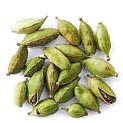In an earlier post I wrote about mustard oil, especially in regard to how it compares with olive oil. Mustard oil, I thought, hails from India – it’s a quintessentially Indian oil, as olive oil is essentially Mediterranean in origin.
Recently, though, I came across a mustard oil brand from Australia. And I am happy to note – from a brief New York Times article – that mustard oil is now being used as a specially flavored oil in the United States and other countries.
The brand mentioned in the article is Naturally from Nature (www.naturallyfromnature.com). Does any reader, in Australia or elsewhere, have any idea about this brand of mustard oil? How does this compare with Indian mustard oil?
Cooking in Calcutta is about cooking Bengali food. But, it's also about cooking in general, its joys and its challenges, and its universal appeal.
Tuesday, July 29, 2008
Monday, July 21, 2008
Striking a relationship with your grocer – II
Over the past few months, I got a call twice from my old sabziwala, Ashok, in Kolkata. He called long distance to say hello to me in Mumbai, filling me with delight. For I was connecting again with my man in Kolkata, my grocer – no, the word doesn’t just do justice – my vegetable vendor, who brought his produce from rural Bengal.
Ashok sold the most tender and the best breed of cauliflower and okra and drumsticks and, in the summer, mangoes. He sold “ol” and yam and some obscure, quintessentially Bengali vegetables.
When I needed something special, like white onion or country tomatoes – not the hybrid variety – he would procure it for me from his farm or elsewhere. And often he would give away something free.
So, when he calls me, I feel happy and nostalgic. In Mumbai, I haven’t been able to forge such a relationship with any sabziwala.
Ashok sold the most tender and the best breed of cauliflower and okra and drumsticks and, in the summer, mangoes. He sold “ol” and yam and some obscure, quintessentially Bengali vegetables.
When I needed something special, like white onion or country tomatoes – not the hybrid variety – he would procure it for me from his farm or elsewhere. And often he would give away something free.
So, when he calls me, I feel happy and nostalgic. In Mumbai, I haven’t been able to forge such a relationship with any sabziwala.
Monday, July 14, 2008
The two faces of cardamom: One subtle, the other bold

In an earlier post I wrote about home-made herbal tea. This post is about the nuances of cardamom – how two kinds of cardamom have two distinct flavors.
The two kinds are small and green, and large and black. A while ago, my mother and I tested the flavors of the two kinds in tea. We made the tea with identical leaves and the same method, but the tea sample with green cardamom had an aromatic, subtle flavor, while the one made with the large variety had a bold, smoky flavor. Our conclusion: they aren’t interchangeable.
 The large cardamom is used extensively in many Indian dishes, including fried rice and biryani. But, I wouldn’t use it in herbal tea; the green small ones are better for that use.
The large cardamom is used extensively in many Indian dishes, including fried rice and biryani. But, I wouldn’t use it in herbal tea; the green small ones are better for that use.Yet, in the end, cardamom remains a mystery to me. When I went to Sikkim, a mountainous state in India’s Northeast, I drank flavorful black (without creamer/milk) tea from porcelain cups with heavy lids that looked like small pots. In the quaint eateries on the mountains overlooking the imposing Himalayan peaks, I found the aroma of cardamom tea unspeakably satisfying. I have no idea which cardamom the tea was infused with; all I know is the tea tasted unlike anything I had drunk before. Maybe it was the locale where the secret lay, where cardamom plants grew in the wild and where the mountains added their charm to anything we imbibed.
Dear reader, which cardamom do you prefer? Do you use both?
Subscribe to:
Posts (Atom)